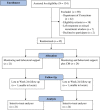Smoking reductions and increased self-efficacy in a randomized controlled trial of smoking abstinence-contingent incentives in residential substance abuse treatment patients
- PMID: 24935755
- PMCID: PMC4271087
- DOI: 10.1093/ntr/ntu095
Smoking reductions and increased self-efficacy in a randomized controlled trial of smoking abstinence-contingent incentives in residential substance abuse treatment patients
Abstract
Introduction: Individuals with substance use disorders (SUDs) experience increased smoking-related morbidity and mortality but severely compromised smoking treatment benefits. Residential SUD treatment settings may be particularly positioned to target smoking, with ever-increasing smoking bans and culture shifts, but most smokers continue smoking. This study examined the effects of contingency management (CM) for increasing smoking abstinence in residential patients.
Methods: Smokers interested in quitting were recruited from a residential SUD program for men and were randomized to frequent smoking monitoring with behavioral support (monitoring; n = 21) or that plus smoking abstinence-contingent (expired carbon monoxide [CO] ≤ 6 ppm; urinary cotinine ≤ 30ng/ml) incentives (CM, n = 24) for 4 weeks. After setting a quit date, procedures included daily behavioral support and smoking self-reports, 2 CO samples (a.m./p.m.) Monday through Friday, and cotinine tests on Mondays. CM participants received escalating draws for prizes ($1, $20, and $100 values) for negative tests; positive and missed samples reset draws. Follow-ups involved samples, self-reported smoking, and self-efficacy (weeks 4, 8, 12, and 24).
Results: Percent days CO-negative was higher with CM (median [interquartile range] 51.7% [62.8%]) compared to monitoring (0% [32.1%]) (p = .002). Cigarettes per day declined and point-prevalence abstinence increased through follow-up (p < .01), without significant group by time effects (p > .05). Abstinence self-efficacy increased overall during the intervention and more with CM compared to monitoring and was associated with abstinence across conditions through follow-up.
Conclusions: CM improved some measures of response to smoking treatment in residential SUD patients.
© The Author 2014. Published by Oxford University Press on behalf of the Society for Research on Nicotine and Tobacco. All rights reserved. For permissions, please e-mail: journals.permissions@oup.com.
Figures


References
-
- Agency for Health Care Policy and Research. (1996). You can quit smoking: Consumers guide Retrieved September 22, 2005, from www.cdc.gov/tobacco/quit/canquit.htm
-
- Alessi S. M., Badger G. J., Higgins S. T. (2004).. An experimental examination of the initial weeks of abstinence in cigarette smokers. Experimental and Clinical Psychopharmacology, 12, 276–287. - PubMed
-
- American Psychological Association. (2000). Diagnostic and statistical manual of mental disorders (DSM-IV-TR) (4th ed., text revision). Washington, DC: American Psychiatric Press, Inc.
Publication types
MeSH terms
Substances
Grants and funding
LinkOut - more resources
Full Text Sources
Other Literature Sources
Medical

